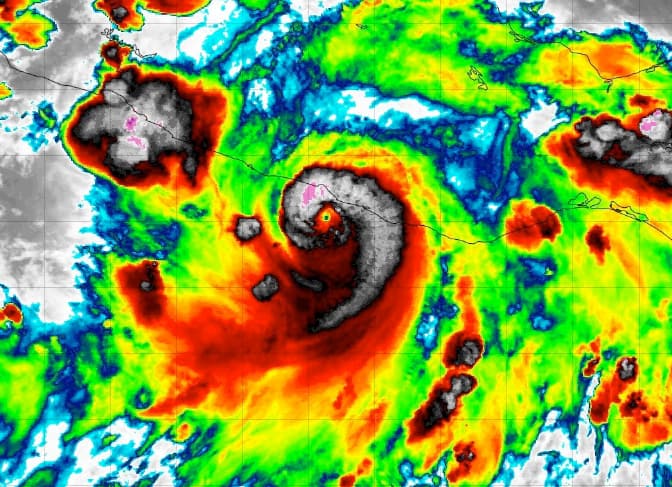Mexico parametric cat bond safe from hurricane John’s 120mph landfall

While the focus for many is on what is still potential tropical cyclone nine and soon to become storm Helene on the Atlantic side, off the Pacific coast of Mexico hurricane John rapidly intensified and made landfall as a Category 3 storm which has resulted in enquiries from catastrophe bond investors.
As said, most of the insurance, reinsurance and insurance-linked securities (ILS) community are watching what is expected to become hurricane Helene moving around the Yucatan Peninsula of Mexico, but we’ve had a number of enquiries overnight about what hurricane John on the Pacific side of Mexico may have meant for the World Bank facilitated IBRD catastrophe bond.
Hurricane John made landfall on the southern coast of Mexico earlier this morning, impacting the region just south-southwest of Marquelia, Mexico in the state of Guerrero.
At landfall, the NHC puts hurricane John’s maximum sustained winds at an estimated 120 mph, while the storms minimum central pressure is estimated at 959 mb.
The enquiries we’ve fielded overnight from both catastrophe bond fund investors and some institutions that invest directly, are all focused on the Mexican government’s World Bank facilitated IBRD CAR Mexico 2024 (Pacific) catastrophe bond issuance.
Up to 12 inches of rainfall are expected with hurricane John, as well as a life-threatening storm surge and hurricane force winds, so it is a potentially deadly hurricane for those in its path.
But, after analysing documents related to the trigger of this Pacific coast hurricane cat bond, we can report that John is not sufficiently powerful to cause any loss to the Mexican governments parametric catastrophe bond.
The Government of Mexico secured $175 million of parametric Pacific named storm disaster insurance protection from the capital markets through the IBRD CAR Mexico 2024 (Pacific) catastrophe bond issuance back in May this year.
The Pacific named storm cat bond’s parametric trigger allows for a linear payout, from 25% upwards, depending on the parameters of a hurricane’s location and minimum central pressure.
In the case of hurricane John, which is estimated to have had minimum central pressure of 959 mb at landfall, that was too high to activate the parametric trigger of Mexico’s cat bond.
The Pacific named storm parametric catastrophe bond requires a storm with a central pressure of 937 mb or lower for even the lowest level of payout, 25% of principal, to be due.
As a result, the holders of this World Bank supported catastrophe bond are safe from any loss of principal.
Hurricane John is another example of a storm rapidly intensifying as it approached landfall and outperforming what many of the models had predicted even 24 hours prior to reaching the Mexican coast.
Had John began its intensification run a little further offshore and had additional time to strengthen and deepen, we might have been looking at a very different scenario for holders of these catastrophe bond notes.
You can read all about this IBRD CAR Mexico 2024 (Pacific) catastrophe bond and more than 1,000 other cat bond transactions in the extensive Artemis Deal Directory.






